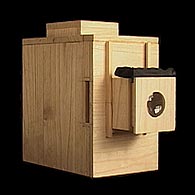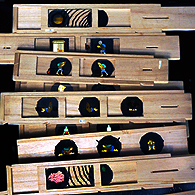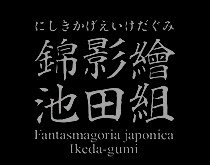
The projector "Furo" is made of paulownia wood, a lightweight wood and easy to manipulate. Projection can be controlled by a black curtain hanging over the lens. A lamp wicks soaked in rape seed oil was used for the light source in those days.

The slide carrier "Taneita" is also made of paulownia wood for housing painted slides. Flat glass called "Video" was used for the slide before, but it is now replaced by a clear plastic plate. Various manually operated mechanisms are used to stimulate motions.
■ From the Western magic lantern to shows using a wooden slide projector and eventually "Nishiki Kage-e"
In his "Rangaku Kotohajime" (memoirs of his early years studying Western science through the Dutch language), the scholar Genpaku Sugita writes that the Western slide projector
("Toverlantaarn", Dutch for "magic lantern") made its way to Japan in the Meiwa Era (1764 -- 1772) through Japan’s interest in Western knowledge.
It was reported in 1779 via the "Tengu-tsu" publication that explained magic tricks that a wooden slide projector known as the "Kage-e Megane" and modeled
after the actual projector brought from Europe was sold at eyeglasses shops and had met with great reviews when demonstrated in Namba-shinchi, Osaka.
It is also found in "Setsuyo Kikan" (recount of manners and customs of Osaka) written by playwright and historian Utakuni Hamamatsu that the "Kage-e Megane"
shown in 1790 in Namba-shinchi was a big hit. In Kamigata (the name of which still indicates the cultural areas of Osaka and Kyoto) and the surrounding areas,
several wooden slide projectors were used early on with narration and music in Joruri (type of sung narrative with shamisen accompaniment) and Kabuki performances,
to project stories on a Japanese paper screen. According to the most recent research that looked closely at those programs and the wooden "Zashiki Kage-e" projectors
that were a newly discovered pleasure for small groups to enjoy in the privacy of a "Zashiki" (private room used for parties, etc.) and the "Taneita" (slide carriers) that were used with it,
it is thinkable that narrative presentations using wooden slide projectors were already an established format across Kamigata.
In the Tenpo Era (1830 -- 1844), Tosho Fujikawa (the First, promoter) organized performances in Osaka dubbed "Nishiki Utushi-e."
He had added the letter "Nishiki" (brocade) to the term "Utsushi-e" that was used in Edo (now Tokyo) to describe performances using the wooden slide projector,
because it had a colorful and fresh image. That eventually became known as "Nishiki no Kage-e," which was then shortened to "Nishiki Kage-e,"
which stuck in Kamigata and surrounding areas.
■ "Utushi-e" that became widely popular in Edo
Not before long, the shows that were the rage in Namba-shinchi, Osaka because of the wooden slide projector made news in Edo.
In 1801, shows were being presented in a show tent in Ueno-hirokoji using what was now being called an "Ekiman Kyo."
Two years later, Toraku Sanshotei (illustrator of dyed fabric) operated a wooden slide projector at the Kasugai teahouse in Ushigome-kagurasaka for performances known as "Edo Utsushi-e"
that were opened to the public. An admission was charged.
This is how "Utsushi-e" performances using the wooden slide projector came to be and spread in Edo. The success that they had can be understood from the "Uchiwa-e"
("Ukiyo-e" painted on a fan) and inserts for readers depicting people watching a magic lantern that popular "Ukiyo-"e artist at the time Kuniyoshi Utagawa painted.
■ Merged with other traditional arts to enhance the imagery
"Nishiki Kage-e" is a shadow play on the screen using the projectors behind the screen: a number of wooden magic lanterns known as "Furo" project images from behind the wide screen
which is composed of several sheets of handmade paper. It led to the Phantasmagoria that the Belgium physicist Etienne Roberston staged
in France at the end of the 18th century, using multiple magic lanterns, smoke and semitransparent curtains.
"Nishiki Kage-e" tells stories on the screen accompanied by music, sound effects and carefully timed narrations. The stories are often taken from "Kabuki" or other traditional performing arts
and their popular characters are ghosts and goblins. Since the plays are mostly performed on the somber back stage behind the screen, so that the performance stirs our imagination
and evokes a strong presence of those eerie beings in the underworld.
■ The addition of movement and color
For his Phantasmagoria, Etienne Robertson mounted a heavy, hot metal magic lantern on a wheeled dolly. On the other hand, "Nishiki Kage-e" used a furo magic lantern made of lightweight,
heat-resistant paulownia wood that the operator could freely carry about while projecting images.
Visual effects can be produced, such as cutting in/out, fading in/out, zooming and overlapping by skillfully operating the black curtain that functions as a shutter in front of the projection lens.
Visual effects can also be heightened not only by changing the projection distance but by extending or by retracting the lens as well as by using multiple ” Furo” to overlap the images.
By moving the "Furo" and by changing the pictures with a mechanism that loads the "Taneita" (slide carriers), images can move freely and energetically in tune with the narration and music.
Particularly, one of the biggest characteristics of "Nishiki Kage-e" is in that the visual expression is closely tied to the physical movements of the operators and it produces a peculiar
"Kehai" (something that cannot be seen but can be subtly perceived through the air).
Another thing is that a technique used back then for dyeing fabrics was applied to making the glass plates that would later serve as slides.
The plates were colored with dyes that allowed light to pass, while their edges were blackened with "Sumi" ink.
Viewers were dazzled by the vibrant colors that seemingly floated out of the darkness. Having evolved into free movement and vivid colors,
"Nishiki Kage-e" captivated audiences and established its own culture as an art.
■ From its decline to its creative resurrection
Once having established itself a name as a performing art, "Nishiki Kage-e" became so popular that small permanent theaters were built everywhere.
That popularity continued beyond the Meiji Restoration, but eventually waned as the cinema came splendidly about and spread as a new form of visual entertainment.
By the early Showa Era, "Nishiki Kage-e" was out of fashion.
Around the mid 1970s amidst growing opportunities to revisit the traditional arts, efforts began in various parts to revive "Nishiki Kage-e."
The Nishiki Kage-e Ikeda-Gumi led by Professor Mitsue Ikeda of the Osaka University of Arts recognized "Nishiki Kage-e" as the origin of Japanese animation and,
thus, launched the "Nishiki Kage-e Art Project" with the objective of rediscovering the creativity and artistry of this lost art.
The project was not only about restoring the equipment and setup of this traditional art but also about resurrecting it as modern art by creating and showing new stories
that bring out its charm.
So that people everywhere could see for themselves the charm of "Nishiki Kage-e," performances were done in and around Osaka. Besides that, a workshop was also launched
where people could become more familiar with "Nishiki Kage-e" by actually making "Taneita" (slide carriers), operating the "Furo" and taking part in brief performances.
In these busy days when digital contents invade our life, "Nishiki Kage-e" is a wonderful form of art that rouses our sense of nostalgia and stimulates our imagination.
The treatise published in the journal of The Magic Lantern Society of the United States and Canada
"Nishiki Kage-e (Japanese Magic Lantern): Characteristics and Establishment of Its Performing Space -- Mitsue Ikeda, Director, Nishiki Kage-e Ikeda-Gumi"







